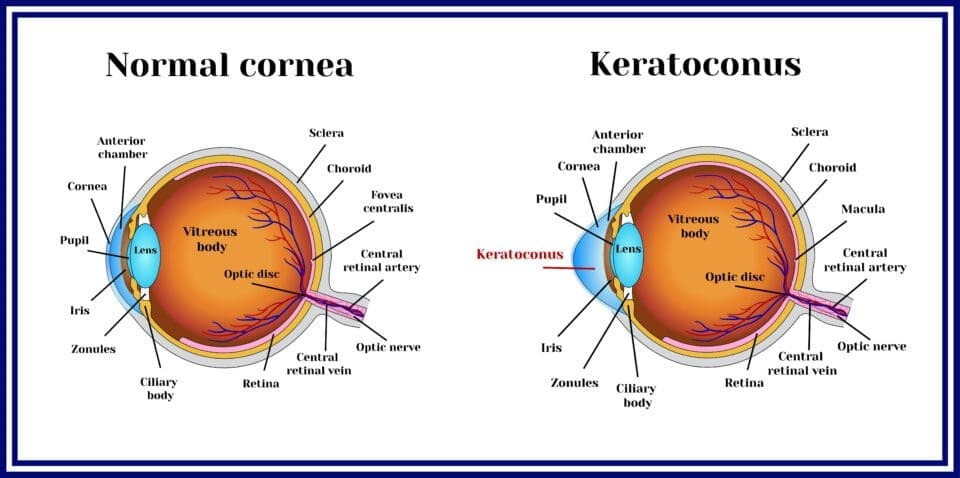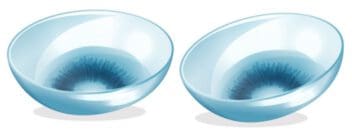Further Reading
Keratoconus Lenses: What Are the Best Kinds in 2022?
Home / Understanding Contacts /
Last Updated:
Keratoconus is a progressive eye condition that generally begins in late adolescence or early adulthood. It involves the cornea getting too thin and bulging into a cone-like shape.
Table of Contents
This can cause distorted and blurry vision, as the light rays are no longer focused into your eyes the way they should be. It can cause nearsightedness and irregular astigmatism.
Lenses that are made for keratoconus can be fitted to improve vision.
Over the past several decades keratoconus lenses have evolved from blown glass lenses to rigid, hard, rigid gas permeable (RGP) lenses to several variations of soft and custom lenses. People who struggle with mild to moderate keratoconus can benefit from these specialized lenses. More severe forms of keratoconus may require a surgical or corneal cross-linking procedure.
Keratoconus lenses today include RGP lenses, soft lenses, piggy-back lenses, hybrid lenses, toric lenses, “vaulting” lenses, scleral lenses, and custom-made soft contact lenses.
Depending on the severity of keratoconus, shape of your eye, and personal details, one type of lens may be better suited than another. Your eye doctor can help you decide on the optimal treatment for keratoconus.
How Do Keratoconus Lenses Work?

Keratoconus is an irregular astigmatism that is caused when the cornea gets too thin and forms a cone. This formation disrupts the way light rays are bent into the lens and makes it harder to focus. Distorted and blurry vision are often the result. You can also become sensitive to light and glares.
Keratoconus is a progressive disorder that can continue to get worse with time. It usually becomes noticeable in late teenage years or in the early 20s. It may occur in just one eye or in both eyes.
You deserve clear vision. We can help.
With 135+ locations and over 2.5 million procedures performed, our board-certified eye surgeons deliver results you can trust. Your journey to better vision starts here.
A comprehensive eye exam and lens fitting is essential, as keratoconus can vary greatly from person to person. Your eye doctor will need to take precise measurements to determine which type of lens to use and fit one for you specifically.
Keratoconus lenses are designed to refocus light, so you can see things more clearly. As the disease progresses, your prescription or even the type of lens may need to change.
If your keratoconus is mild, you may benefit from a specialized contact lens to correct your vision.
Evolution of Keratoconus Lenses

In the late 1800s, contact lenses for treating keratoconus were made out of blown glass. By the 1940s, this had evolved to hard, plastic, rigid gas permeable (RGP) lenses. For many years, this was the gold standard.
These lenses sit on top of the corneal cone and typically will fit around the apex of the cone. This can be problematic, as the cone may not be in the direct center of the eye. These lenses can also be less comfortable than soft contact lenses and take longer to adjust to. Debris can get trapped under an RGP lens, and they may also increase the risk for corneal scarring related to keratoconus.
In order to increase comfort and decrease some of the potential side effects of RGP keratoconus lenses, the piggy-back option was introduced. This method places a soft contact lens underneath the RGP lens, which can then offer cushion and protection to the cone’s apex.
Keratoconus lenses have also evolved into “vaulting” style lenses that include both scleral (lenses that are bigger in diameter than traditional lenses) and hybrid (lenses made up of multiple materials) lenses that can decrease the risk for scarring by vaulting over the cornea. These lenses do not actually touch the apex of the cone and can allow more oxygen to flow through them.
Today, there are also custom soft toric contact lenses that can be made to fit your eye exactly. There are many options today when it comes to keratoconus contact lenses.
Comparison of Keratoconus Lenses Today

Contact lenses, and especially contact lenses for conditions like keratoconus, are highly individual, and different types of lenses work better for different people. The shape of the cone, severity of the disease, and comfort level can all play a role in which type will work best for you.
Specialized keratoconus contact lenses can improve vision, and they may also be able to delay or minimize the need for surgery.
The following are explanations of the different choices on the market today for keratoconus lenses:
- Rigid gas permeable (RGP) lenses: These are still some of the most widely prescribed lenses for keratoconus, and they are typically considered the first-line They are rigid and hard and made of materials that are gas permeable, meaning that oxygen can flow through to the lens. RGP keratoconus lenses create a new refractive surface, as an alternative to the irregularly shaped cornea, which can then improve and sharpen vision as a result.
- Soft toric lenses: Toric lenses are designed to manage astigmatism. These lenses have advanced a lot over the years to become a comfortable and viable option for treating keratoconus. They may not be specialized enough, depending on your eyes and the degree of the disease.
- Piggybacking lenses: This system uses two lenses: one soft contact lens and one RGP lens. The soft lens is placed under the RGP lens to provide a higher level of comfort and to protect the cornea from the RGP sitting directly on top of it and causing irritation or scarring. It can be more complicated to have to manage multiple lenses at a time, however.
- Hybrid lenses: These lenses typically have a rigid gas permeable center and a soft silicon hydrogel outer ring. A hybrid lens can offer both the comfort and stability of a soft lens with the clear vision of the more rigid lens in the middle.
- Scleral lenses: Wider in diameter than traditional contact lenses, scleral lenses can vault over the corneal apex more completely and cover larger areas of the eye, which can in turn improve the astigmatism and refractive errors for enhanced vision. They are often more stable and may be a great option if you are very active or play sports. Scleral lenses can provide an optimal fit and high level of comfort as well as some of the best vision correction for keratoconus.
- Custom soft contact lenses: These are an upgrade on traditional soft toric lenses as they are made specifically to fit your eyes. They are more expensive than other keratoconus lenses, but they may be the most comfortable and offer the most direct fit and vision correction. In the United States, Bausch + Lomb currently markets two custom soft contact lenses for keratoconus: KeraSoft lenses (made of silicon hydrogel) and NovoKone lenses (hydrogel lenses).
Keratoconus lenses are highly specialized and depend on personal comfort, fit, and preferences. Work with your eye doctor to decide which lenses will work best for you.
Typical Costs for Lens Types
RGP Lenses:
- Paragon HDS Contact Lenses – $33.99 / Lens
- Polycon II Contact Lenses – $45.00 / Lens
- Fluoroperm 30 Contact Lenses – $32.99 /vial
Scleral Lenses:
- So2Clear Corneal Scleral lens – $400
- SynergEyes GP II Bitoric lenses – $325
Scleral lenses fetch a much higher fee than other contact lenses because these lenses are custom-made to fit the exact eye specifications of the wearer. There’s also more work involved in prescribing these lenses. Their lifespan can exceed those of other types of lenses, which may contribute to their overall pricing.
Keratoconus and the Coronavirus
As always, proper hygiene is paramount when handling contact lenses to control keratoconus. This means washing your hands thoroughly and rinsing your contact lenses in the recommended solutions before wearing them.
Wearing lenses during the Covid-19 outbreak remains as safe as ever. At the same time, you want to follow all the set guidelines to avoid inadvertently transmitting the virus into your eyes through your lenses.
You deserve clear vision. We can help.
With 135+ locations and over 2.5 million procedures performed, our board-certified eye surgeons deliver results you can trust. Your journey to better vision starts here.
References
- What Is Keratoconus? (March 2019). American Academy of Ophthalmology (AAO).
- The Evolution of Keratoconus Care. (June 2015). Review of Cornea & Contact Lenses.
- Contact Lenses in Keratoconus. (August 2013). Indian Journal of Ophthalmology.
- Contact Lenses for KC. (2019). National Keratoconus Foundation (NKCF).
- The Best Contact Lenses for KC. (2019). National Keratoconus Foundation (NKCF).
- What Are the Best Contact Lenses for Keratoconus? (February 2018). All About Vision.
- Keratoconus Causes, Symptoms, and 10 Treatment Options. (December 2018). All About Vision.
- Anatomy of the Eye. (2001). Neuroscience.
- Keratoconus. (February 1, 2021). Genetic and rare Diseases Information Center.
- Coronavirus. (2021). World Health Organization.
- What to Expect When You Have a Corneal Transplant. (February 28, 2020). American Academy of Ophthalmology.
This content is for informational purposes only. It may have been reviewed by a licensed physician, but is not intended to serve as a substitute for professional medical advice. Always consult your healthcare provider with any health concerns. For more, read our Privacy Policy and Editorial Policy.